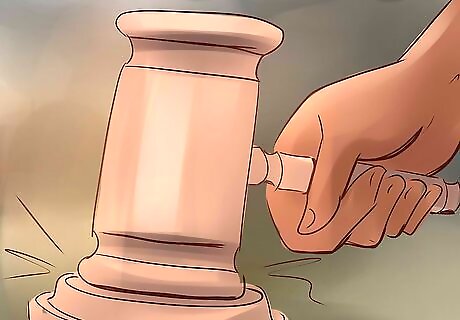
views
X
Research source
Drafting Your Answer

Read the summons and complaint. The initial documents you receive inform you that a lawsuit has been filed against you and how long you have to respond. The summons gives you the name and contact information of the agency or insurer suing you, as well as your deadline for responding. You typically have 30 days or less to respond to the lawsuit, or the plaintiff may win by default. The complaint contains important information about the specific allegations of the lawsuit. Review these carefully and consider how you will respond. Don't be afraid to contact the plaintiff using the information provided in the summons to attempt to work out a settlement.

Gather information. Before you start drafting your answer, take a minute to compile any documents you have about the disability and benefits that are the subject of the lawsuit. Keep in mind that the alleged fraud can take many forms. The agency or insurance company may not dispute that you are disabled, but claim that you provided inaccurate information about your income or marital status. Depending on the allegations in the complaint, you may need to gather personal documents such as marriage or divorce decrees, or information about your work such as your schedule or recent pay stubs. You also should find copies of any medical reports you have, especially notes from your doctor with work or other physical restrictions and anything pertaining to your disability.

Search for templates. Many courts have templates you can use to format your answer, available online or from the clerk's office of the court where the lawsuit was filed. If you can't find a fill-in-the-blank form or template, ask the clerk for an answer filed in another case that you can use as a guide when you format your own. Generally, you want to use a word-processing application to type your answer on standard 8.5 x 11 white paper with one-inch margins all around. In most applications this the default formatting style. Copy the caption from the complaint on the top of your first page. This identifies the case to which the document belongs, and includes the court's name, the case name, and a case or file number.

Respond to the allegations. You must respond to each numbered paragraph of the complaint and admit or deny the allegation it contains. Throughout your answer, you should refer to yourself as "Defendant" and to the agency or company that has sued you as "Plaintiff," rather than using names or writing in first person. The plaintiff has the burden of proof in a lawsuit. If you deny an allegation, you aren't necessarily saying it isn't true; rather, you're forcing the plaintiff to prove it. If you admit an allegation, you've relieved the plaintiff of the burden of proving that allegation. Your responses can be as brief as one word: either "admit" or "deny" following the paragraph number that corresponds to the allegation. You also can respond by saying that you don't have enough facts to admit or deny the allegation. These type of responses are treated the same as denials by the court.

Sign your answer. Your completed answer should be printed, signed, and dated so you can file it with the court. When you've signed your answer, make copies of it before you take it to the clerk of court's office. You'll need at least one copy for your own records and one to have delivered to the plaintiff.
Preparing Your Defense

File your answer. You must file your answer with the clerk of the court where the lawsuit was filed by the deadline listed on your summons. The clerk will stamp the original and your copies "filed" and give the copies back to you. Once your answer is filed, you are responsible for having it delivered to the plaintiff. The court system requires documents be delivered in a particular way so you have proof the other party received them. This is called "service." The clerk will have the forms you need to complete this task. You may want to have your answer hand-delivered, using the sheriff's department or a private process serving company. However, the easiest way to complete service is to mail your answer using certified mail with returned receipt requested.

Gather documents and information. Depending on the allegations against you, certain personal records may be necessary to your defense. For example, suppose you applied for disability benefits from a state agency and listed your marital status as "divorced." However, your divorce had not yet been finalized. The agency has sued you alleging that you lied about your marital status so you would be eligible for more benefits. In that example, a copy of your divorce decree would support your defense that you didn't intentionally lie to get more benefits. If the decree is dated prior to the date you started receiving benefits, you would have a stronger argument that not only was there no fraudulent intent, but you didn't receive any benefits to which you weren't entitled.

Consider consulting an attorney. Because a disability fraud lawsuit could result in criminal charges and even jail time, an experienced disability attorney is essential to protect your rights. Check the website of your state or local bar association for a directory of licensed attorneys who practice in your area. Typically you can limit your search results to a particular area of law. Even though you're defending yourself in a civil suit, attorneys with experience in criminal fraud cases also may be able to advise you on possible defenses or types of evidence that you would otherwise overlook on your own. If you're concerned about your ability to afford an attorney, you can check with your local legal aid office. Even if they don't take your type of case, they may have resources available with other low-cost options.

Participate in discovery. Through the discovery process, both you and the plaintiff can exchange information about the case and evidence you plan to use in court. Discovery typically consists of both written discovery and depositions. Written discovery allows each party to send the other written questions or requests for copies of documents or other evidence related to the lawsuit. The questions are answered under penalty of perjury. If you receive written discovery, the court has deadlines by which you must provide the plaintiff with your answers. Depositions give you the opportunity to interview parties or witnesses under oath. The interview will be transcribed by a court reporter so you can refer to it later. Just as the plaintiff can send you questions, you can also ask for information or records related to the lawsuit. At the very least, you should request a copy of your file from the agency or insurance carrier. The file includes information on your disability claim and the reasons you are suspected of fraud. If the plaintiff's allegations are based on a report from another person that you aren't disabled as you claim or are otherwise ineligible for benefits, you should request a copy of that person's report as well as information regarding that person's identity and relationship to you.

Work with your doctor. If you've been accused of disability fraud, your doctor's testimony may crucial to your defense. If the fact that you are disabled isn't in dispute, you typically won't need to worry about getting testimony from medical professionals. However, if the plaintiff alleges you aren't disabled, or aren't disabled to the extent you claim, you typically will need professional medical opinions to back up your claims. The plaintiff may want you to visit another doctor for a second opinion on your disability. Typically you won't have to pay for this evaluation. Make sure you keep that appointment and are completely open and honest with the doctor who evaluates you so you receive a fair assessment of your condition.

Remain open to a settlement. You may be able to work with the agency or insurance company to resolve the dispute without having to go to court. Particularly if the allegations have occurred as a result of a misunderstanding or mistake on your part, the dispute should be relatively straightforward to resolve. You might want to consider using a mediator to reach a settlement on the dispute. The clerk's office typically will have a list of mediators approved by the court to assist in resolving disputes. Some courts require parties to attempt mediation before a case can go to trial. Typically neither party will be charged any fees for mediation if it is required by the courts.
Attending Your Trial

Organize your evidence. To prepare for trial, you should create an outline of your defense with notes regarding documents you want to present or witnesses you want to call. Make a chronological list of everything that happened in the case, from the onset of your disability through your application for benefits. For disputed information, include evidence to back up your claims or explain why you provided the information you did at the time. If you have documents you want to present as evidence at trial, make at least two copies so you can pass them out to the judge and the plaintiff. Meet with your witnesses before trial and go over the questions you plan to ask. At trial, you'll want to avoid asking any witness a question to which you don't know the answer – the response may hurt rather than help your defense. You also may want to brainstorm possible questions the plaintiff may ask on cross-examination. If you're representing yourself rather than using an attorney, you may want to go to visit the court before your trial to observe other cases. This will help familiarize you with court conduct and procedure and feel more confident presenting your defense.

Appear on your court date. Make sure you get to the courthouse at least a half hour before the time listed on your summons or notice of hearing so you have time to go through security and find the right courtroom. If there are other cases being heard in the same courtroom, take a seat in the gallery until the judge calls the title of your case. Then you can go up to the front of the courtroom with the plaintiff and take your places at the tables reserved for the parties in a case.

Listen to the plaintiff's case. Typically the plaintiff or his or her attorney will speak to the judge first and explain the allegations against you. Don't interrupt the plaintiff or the plaintiff's attorney when he or she is speaking. If you disagree with something that is said, simply make a note of it so you can bring it up later – refrain from noise or outbursts. The plaintiff may call witnesses. You or your attorney will have the opportunity to cross-examine them after the plaintiff has finished asking questions, so pay attention and take note of anything the witness says about which you want to ask further questions.

Present your defense. When the plaintiff is finished, the judge will call on you to tell your side of the story and explain why you didn't commit disability fraud. Stick to your original outline, focusing on the most important parts of your defense. Try not to let anything the plaintiff said derail your presentation. Make your points quickly, and stick to the facts. Avoid trying to appeal to the judge's emotions, or making personal statements about the plaintiff or any of the plaintiff's employees or representatives who dealt with your disability claim.

Wait for the judge's decision. The judge may issue a ruling on the bench or review the documents and evidence in the case privately before making final judgment. If you don't receive the judge's ruling the day of your trial, you should ask the clerk when you can expect the judge's decision and how you will be notified when the order is entered. If the judge doesn't rule in your favor, you will have a limited period of time to decide what you want to do next – if you want to appeal the ruling or file some other post-judgment motion. If you don't already have one, consult an attorney as soon as you've received the order to find out what options you might have.




















Comments
0 comment